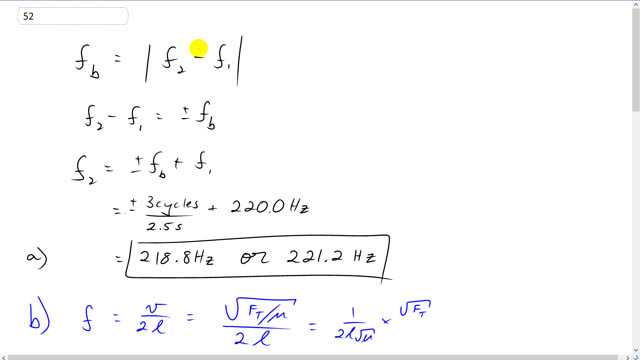
Two piano strings are supposed to be vibrating at 220 Hz, but a piano tuner hears three beats every 2.5 s when they are played together.
- If one is vibrating at 220.0 Hz, what must be the frequency of the other (is there only one answer)?
- By how much (in percent) must the tension be increased or decreased to bring them in tune?

In order to watch this solution you need to have a subscription.
This is Giancoli Answers with Mr. Dychko. The beat frequency is the difference between the two different frequencies. And I have absolute value here because it doesn't matter whether the difference is positive or negative. The beat frequency will be the same either way. So, this means that the difference is either the positive or the negative of the beat frequency. Sorry. And so f2 is beat frequency plus f1. And so you can take the beat frequency to be positive or negative, hard to tell, and that's 3 cycles for every 2.5 seconds and plus 220 hertz. So, the frequency of the second string will be either 218.8 hertz or it'll be 221.2 hertz. Now, as for the tension in the strings, we know that frequency is the wave speed n the string divided by 2 times its length. And wave speed is going to be square root of tension divided by mass per unit length. And we assumed that the length of the strings and their mass per unit length are the same. And so I don't need any subscripts there for this second line here written in green. So, we have, for the final frequency it's going to be 1 over 2 l times square root of μ times square root of tension force in the final case after changing the tension. And we're going to divide that by the initial frequency which is the same as multiplying by the reciprocal. And so we're gonna multiply by the reciprocal this. So, that's 2π or 2 l times square root μ divided by square root of tension force initially. And then this 2 l square root μ business cancels. And the final frequency divided by initial frequency is the square root of the final tension divided by the initial tension. So, we square this and square this as well. And we get that the final tension divided by initial tension is the final frequency divided by initial frequency squared. And the final tension is this multiplied by the ratio frequency squared. So, the percent change in tension is the final tension minus the initial tension divided by the initial tension times 100%. And this is substituted in place of final tension. I've written that in terms of initial tension and you know you can divide both terms on top by this initial tension and you get just the final frequency divided by initial frequency squared minus 1. Times 100%. And so the percent change in going from 218.8 hertz to 220 is the final frequency of 220 hertz divided by 218.8 hertz squared minus 1 times 100% gives 1.0999, and that's about 1.1% and that's positive, which means the tension has to be increased in order to increase the frequency. Changing from 221.2 hertz to 220, take the ratio frequency squared, and that gives minus 1 like it is negative 1.08205% which is negative 1.1%, and that's negative, that means you have to decrease the tension in order to go from this frequency to that one.